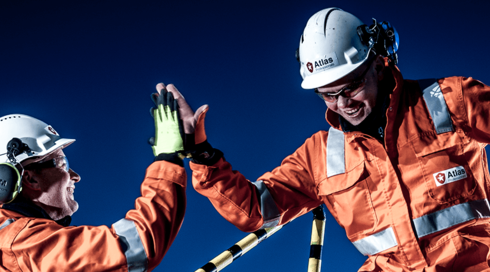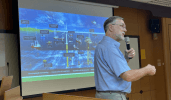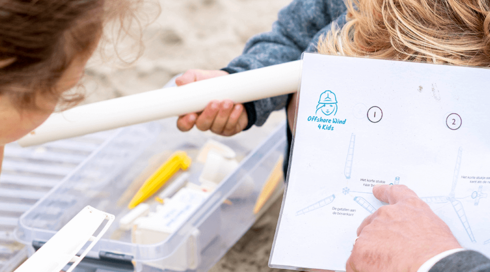2
“Offshore wind had never been considered in the Southern Hemisphere until about seven years ago when we initiated the project and set up a company”
More than once called an ‘ambitious project’, Star of the South is Australia’s first proposed offshore wind farm. In fact, it is a Southern Hemisphere first according to the project’s CEO and co-founder Andy Evans.
Star of the South was founded seven years ago by Andy and two partners, who were looking at several renewable energy business opportunities in Australia. “We came across this potential, based mainly on the state of Victoria’s energy requirements. Its six million people will require greater electricity supply in coming years due to potential closures of coal-fired generators.”
On 29 March 2019, the Commonwealth Government granted the project, which is backed by Danish fund management company Copenhagen Infrastructure Partners (CIP), an exclusive exploration license to investigate the technical feasibility of constructing wind turbines in the ocean off the south coast of Gippsland, Victoria. The up to 2200MW wind farm would generate roughly the same energy of the now-closed Hazelwood coal-fired power station and supply about eighteen per cent of the state of Victoria’s electricity requirements.
The winds of change
With the need for a diversified energy mix, coal-fired generators reaching the end of their lifetime and electricity prices spiking due to reduced supply, the argument for renewable energy is no longer only about environmental concerns. “The economics and investment dollars are really starting to support renewable energy,” says Andy. “Support is needed to assist coal-fired power generation with many forecast closures. It’s also very clear that the investment market, whether it be through banks or through private investment, is supporting alternatives to coal.”
According to Andy, Australia is getting to a stage - whether it chooses to realise it or not - where coal generation will be phased out over the next 30 years. “When we look at opportunities to then introduce new energy sources, we see offshore wind in particular as a key force in new energy generation. We think that there are probably a further two to three projects that will assist to meet Australia’s energy requirements.”
Managing the cost perception of offshore wind however, is one of the key challenges for Andy and his team. “Deploying offshore wind is obviously a bit more costly at the moment. People would look at it initially and go ‘look, isn’t it expensive'. But when you look at it economically, from a supply and demand perspective, it actually reduces electricity prices by increasing supply.”
Location is key
That’s simple enough, one might think, but why would you build wind turbines offshore in a country that has so much space? “The problem is that nobody lives in that space,” Andy explains. “With 85% of Australia’s population living within 50km of the coastline, most of the power generation and distribution systems have been built around coal generation, which is generally much closer to the capital cities.”
“We’re finding that particularly in Western Victoria, where there is a lot of strong wind and solar potential, there is not that grid capacity to actually transmit the electricity to consumers,” Andy continues. “The ability to build large scale capacity facilities for energy generation on land obviously also has a lot of competition with agricultural or residential land. Looking offshore is a key opportunity where you don’t have a lot of competing interests around using that space.”
With the wind farm located of the south coast of Gippsland, three hours south of Melbourne, the project would also provide job opportunities for the region’s people. “Part of the reason we chose Gippsland and Latrobe Valley is their century’s worth of power generation and mining experience, but also 50 years of offshore and oil and gas exploration experience,” says Andy. “There would be a number of jobs in the region, but it will also need to be topped up by international experience.”
Atlas Professionals and Star of the South Announce Joint Labour Market Study for first Offshore Wind Project in Australia.
Regional and international human capital
The human capital challenge in the renewables industry is nothing new and also applies to the team at Star of the South, which currently has seven Europeans among its staff of thirteen. “The problem is that offshore wind, globally, is a fairly new industry. The key markets and the technical capabilities are in Denmark, the UK, Germany and the Netherlands. It’s a pretty limited skill set base at the moment and finding people with a relevant background is fairly challenging.”
The number of people who already have got offshore wind or marine environmental experience in Australia is very limited. “Offshore oil and gas are a key potential service provider for us,” says Andy. “Atlas Professionals and Ian Marshall in particular have been fantastic in introducing us to a lot of the skill sets that exist in offshore oil and gas, particularly in Western Australia.”
He adds: “I think one of the issues with Australia is that it can be fairly regional, with a lot of very localised expertise. It’s impressive how the Renewables team at Atlas has reached out and established that there is capability beyond its own jurisdictions. The skill sets and experience of other regions will complement each other and be brought to bear on the Australian project. Atlas Professionals has been chosen to be a key HR Strategic Partner to support the expansion of the Star of the South team to up to 25 by the end of 2019 through its executive search services in APAC and the renewables team based in Perth. The project team would expand to 60 by 2022.
Star of the South, Ambition of the South
Aside from striving to build the right project development team, Andy spends a lot of his time working with the Commonwealth and State governments. This is vital as, unlike Europe where governments often initiate and back green energy solutions, there is still a lack of formal legislation around the development of offshore wind farms in Australia.
For Andy, a lawyer by background, this lack of framework and regulation poses one of the major project challenges. “We’ve now got an exploration license, which provides us with real clarity to undertake the key work to get environmental approvals and complete the technical and commercial feasibility. However, regulation and legislation around being able to then operate for a long term of years out in the ocean is still not quite clear.” Yet, Andy remains optimistic: “We have made a great deal of progress since the start of discussions with the Commonwealth Government, but we really need a legal framework to be locked in.”
Star of the South is named after a ship which sailed from England to Victoria in the 1850s, carrying immigrants hoping for a bright new future in Australia. Star of the South clearly reflects a hope for a bright green future for the project’s co-founder. “It’s a project of national significance which will actually form the foundation for not only further offshore wind farms, but also different ways of looking at energy generation in Australia. We hope that everybody can get on board.”
.png)
.png)


